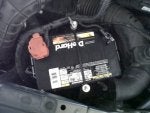I hated to dredge up an old thread, so I started a new one.(I hope it's ok?)
Anyway the old thread is here.> http://www.elementownersclub.com/forums/showthread.php?t=6573
I remember allot of people complaining of having sudden failures of there OPTIMA Batteries.
I had one Red top OPTIMA bite the big one in a very sudden manner myself. Granted I had
it for almost seven years, but it's demise without any kind of warning bothered me. (I've
got a theory about that I'll talk about later.) And I still wanted to have a AGM type
battery so I remembered that Backcountry Edge had bought a DieHard Platinum in group size
35. Well they go for $219.99 not including tax and that was a bit steep for me. And the other
thing is it still didn't have the same or higher amp per hour rating as the red top OPTIMA did.
So I found a DieHard Advanced Gold AGM Battery - Group Size 34R for $144.99 not including tax.
I did give up 5 amp per hour over the Platinum, the gold is rated at 55 @ 20 Hr rate and the
Platinum is 59 @ 20 Hr rate.
Backcountry Edge's post.>
http://www.elementownersclub.com/forums/showpost.php?p=728347&postcount=97
Stats>
Platinum
Amp Hours at 20 Hour Rate:= 59
Cold Cranking Amps (CCA at 0 deg.F)= 740
Reserve Capacity (RC):= 100 min.
4-year FREE Replacement, 100 Month Pro-Rated Limited Warranty
http://www.sears.com/shc/s/p_10153_12605_02850035000P
Gold
Amp Hours at 20 Hour Rate:= 55
Cold Cranking Amps= 775
Reserve Capacity (RC):= 120 min.
3-year FREE Replacement<-As listed on the battery
http://www.sears.com/shc/s/p_10153_12605_02850733000P?mv=rr
Here is the top of the battery(Reversed. The top of the picture is the front of the car)
![]()
Also I used the plastic spacer that the battery came with, it was snapped to the top of the
battery. Make sure it's on the battery when you buy it, some of them where gone on there
batteries in the store. The spacer goes on the bottom of the battery when installed. It
helped the battery fit the OEM battery bracket better. Also you do not need the OEM plastic
battery tray and cover. I was able to reuse the OEM J-bolts but I used a new battery hold down
bar that came from Napa Auto parts and some washers.(I don't remember the part #)
Regular view.
![]()
I'm out of time, I'll post my theory about why the OPTIMA's might be failing
suddenly in a latter post. I need to draw up some diagrams anyway.
Anyway the old thread is here.> http://www.elementownersclub.com/forums/showthread.php?t=6573
I remember allot of people complaining of having sudden failures of there OPTIMA Batteries.
I had one Red top OPTIMA bite the big one in a very sudden manner myself. Granted I had
it for almost seven years, but it's demise without any kind of warning bothered me. (I've
got a theory about that I'll talk about later.) And I still wanted to have a AGM type
battery so I remembered that Backcountry Edge had bought a DieHard Platinum in group size
35. Well they go for $219.99 not including tax and that was a bit steep for me. And the other
thing is it still didn't have the same or higher amp per hour rating as the red top OPTIMA did.
So I found a DieHard Advanced Gold AGM Battery - Group Size 34R for $144.99 not including tax.
I did give up 5 amp per hour over the Platinum, the gold is rated at 55 @ 20 Hr rate and the
Platinum is 59 @ 20 Hr rate.
Backcountry Edge's post.>
http://www.elementownersclub.com/forums/showpost.php?p=728347&postcount=97
Stats>
Platinum
Amp Hours at 20 Hour Rate:= 59
Cold Cranking Amps (CCA at 0 deg.F)= 740
Reserve Capacity (RC):= 100 min.
4-year FREE Replacement, 100 Month Pro-Rated Limited Warranty
http://www.sears.com/shc/s/p_10153_12605_02850035000P
Gold
Amp Hours at 20 Hour Rate:= 55
Cold Cranking Amps= 775
Reserve Capacity (RC):= 120 min.
3-year FREE Replacement<-As listed on the battery
http://www.sears.com/shc/s/p_10153_12605_02850733000P?mv=rr
Here is the top of the battery(Reversed. The top of the picture is the front of the car)

Also I used the plastic spacer that the battery came with, it was snapped to the top of the
battery. Make sure it's on the battery when you buy it, some of them where gone on there
batteries in the store. The spacer goes on the bottom of the battery when installed. It
helped the battery fit the OEM battery bracket better. Also you do not need the OEM plastic
battery tray and cover. I was able to reuse the OEM J-bolts but I used a new battery hold down
bar that came from Napa Auto parts and some washers.(I don't remember the part #)
Regular view.

I'm out of time, I'll post my theory about why the OPTIMA's might be failing
suddenly in a latter post. I need to draw up some diagrams anyway.






